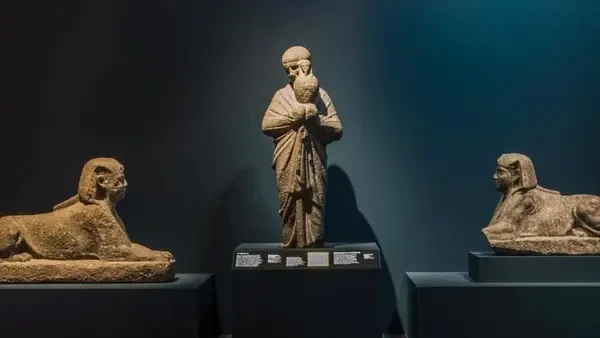Climate changes stimulate desertification processes and its impact on sustainable development in the overlap areas in the South Upper Egypt region - the first phase, Assiut and Siwa governorates.
Summary of project:
The Arab Republic of Egypt is located in the driest region in the world, the Hyper Arid Climatic Zone. The desert represents about 96% of the total area of Egypt. The prevailing drought processes exacerbate the negative impacts of climate change on sustainable development processes. It is noteworthy that the desert areas are rich in containing many natural resources, such as arable lands, pasture lands, and mineral content, in addition to areas suitable for economic wild plants and grazing areas, in addition to the precious metals these areas contain, tourist and historical wealth, and natural treatment clinics. The expansion of productive land areas is considered a major goal in national development plans that are necessary to fill the food gap, whether through agricultural production for local consumption or export and bringing in hard currency. Egypt suffers from an increase in population density in the Nile River Valley, which requires the establishment of new integrated urban communities in desert areas. The South Upper Egypt region is characterized by the availability of good virgin soil for development (agricultural and industrial), in addition to the availability of parts of the necessary infrastructure. The desert back areas in Assiut and Sohag governorates in the Nile Valley, extending within the desert borders, are among the priority areas in the South Upper Egypt region.
The governorates of Assiut and Sohag include productive and living areas on their western and eastern edges, adapted to both the western and eastern deserts, respectively, in addition to their tourism and historical qualifications with the potential for agriculture, hunting, and grazing. Environmental sensitivity to land degradation causes the problem of the formation of air deposits in the form of dunes and sand flats in areas overlapping with the Western Desert, and in the form of valleys, streams, and flood fans in areas overlapping with the Eastern Desert. It was also found that the random withdrawal of groundwater led to a rise in the ground water level and the salinization of the water, and then the interference of salt water with lands with porous sandy soil, causing salinization and waterlogging of the lands, leading to a problem that limits the productivity of these areas. Despite the availability of descriptive studies, the distribution, geographical extent, and geographical relationships between the various processes of desertification and environmental degradation have not been studied. Perhaps developing a quantitative model for these concepts will determine the sensitivity factors for the various environmental components, which will support decision-making for the sustainable development of such areas.
Within the framework of the descriptive and quantitative analysis of development obstacles in Egypt, the priority of arable areas in its deserts becomes clear (such as areas overlapping with floodlands and areas of plains and oases). It is important to point out land degradation, which is the process that reduces the current capacity or the potential capacity of the soil to produce goods or services (Food Organization and Agriculture/United Nations Environment Programme, 1978). It can also be defined as “deterioration of soil quality caused by misuse by man” (Lal and Stewart, 1990) or “a process describing human-induced phenomena, which reduce the capacity of existing soil and / or future" (Ayoub, 1991). Dudal (1982) estimated that about 3.6 million hectares, or 70% of potentially productive drylands, are currently threatened by various forms of land degradation. Coote et al. (1982) emphasized that a distinction can be made between The processes that contribute to land degradation fall into two broad groups, those that can be observed over a wide area and are the result of regional soil management and climatic factors, and those that are localized in extent and are functions of local soil management conditions. Many of these processes are natural and some persist. Without human intervention. Waterlogging and subsequent salinization and/or alkalization are among the most important degradation processes of irrigated agricultural lands in arid and semi-arid conditions (Dwivedi et al., 1999). The governorates of Assiut and Sohag include productive and living areas on their western and eastern edges, adapted to both the western and eastern deserts, respectively, in addition to their tourism and historical qualifications with the potential for agriculture, hunting, and grazing. Environmental sensitivity to land degradation causes the problem of the formation of air deposits in the form of dunes and sand flats in areas overlapping with the Western Desert, and in the form of valleys, streams, and flood fans in areas overlapping with the Eastern Desert. It was also found that the random withdrawal of groundwater led to a rise in the ground water level and salinization of the water, and then the interaction of salt water with lands with porous sandy soil, causing salinization and waterlogging of the lands, leading to a problem that limits the productivity of these areas. Despite the availability of descriptive studies, the distribution, geographical extent, and geographical relationships between the various processes of desertification and environmental degradation have not been studied. Perhaps developing a quantitative model for these concepts will determine the sensitivity factors for the various environmental components, which will support decision-making for the sustainable development of such areas.
The objective of the project:
The studies aim to evaluate descriptively and quantitatively the sensitivity of the environment to the deterioration of land, water and biological resources, and then produce maps of environmental sensitivity to degradation processes in Egyptian lands. The project will include international scientific cooperation with research institutions that are members of the Regional Center for Remote Sensing of North African Countries, whose scientific council seeks to develop a scientific program to study desertification in the North African region, as it became clear from the discussions in the scientific sessions of the desire for scientific cooperation at the current stage in a number of research centers that are members of the Regional Center. Through each institution adopting a similar study at its own national level, with the possibility of arranging scientific meetings and workshops that allow for the exchange of opinions and the transfer of experiences. The results obtained from the project will provide the possibility of participating in regional and global scientific meetings, which contributes to gaining more experience and participating in specialized scientific clusters, Scientific Thematic Networks.
The most important outputs:
Maps of Soil Quality Indices (SQI).
Maps OF Vegetable Quality indices (VQI)
Maps of Climate Quality indices (CQI)
Maps of Desertification Sensitivity Areas (DSA’s).
Maps of Status of land degradation processes
Maps of land degradation rates
Maps of land degradation inherent risk
Maps of land degradation hazard.











